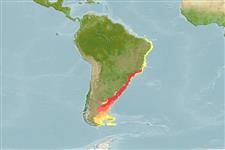Preferred temperature (Ref.
123201): 7.5 - 21.7, mean 13.2 °C (based on 137 cells).
Phylogenetic diversity index (Ref.
82804): PD
50 = 1.0000 [Uniqueness, from 0.5 = low to 2.0 = high].
Bayesian length-weight: a=0.01072 (0.00888 - 0.01293), b=3.07 (3.02 - 3.12), in cm total length, based on LWR estimates for this species (Ref.
93245).
Niveau trophique (Ref.
69278): 3.7 ±0.5 se; based on size and trophs of closest relatives
Generation time: 3.3 ( na - na) years. Estimated as median ln(3)/K based on 2
growth studies.
Résilience (Ref.
120179): Haut, temps minimum de doublement de population inférieur à 15 mois (Preliminary K or Fecundity.).
Fishing Vulnerability (Ref.
59153): Low vulnerability (22 of 100).
Nutrients (Ref.
124155): Calcium = 95.1 [33.5, 203.5] mg/100g; Iron = 0.949 [0.468, 1.873] mg/100g; Protein = 17.8 [16.0, 19.6] %; Omega3 = 0.461 [0.256, 0.823] g/100g; Selenium = 27.1 [13.2, 56.2] μg/100g; VitaminA = 29.1 [8.4, 112.8] μg/100g; Zinc = 0.908 [0.605, 1.386] mg/100g (wet weight);
